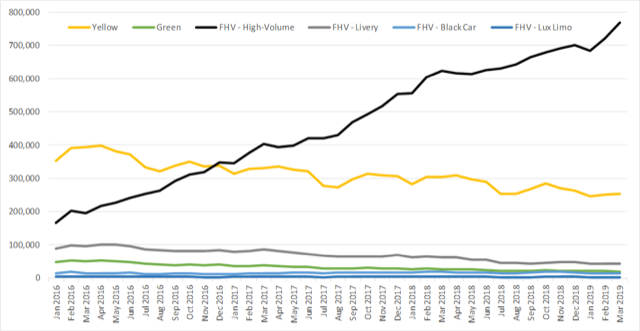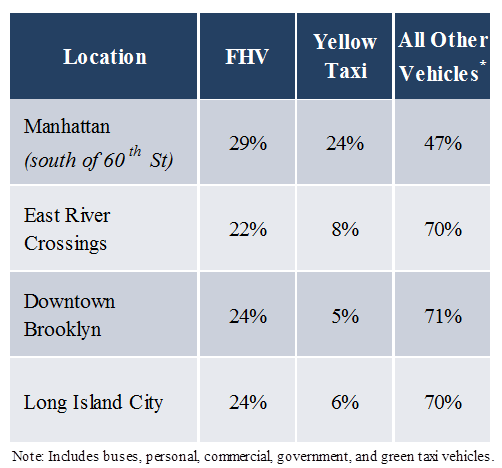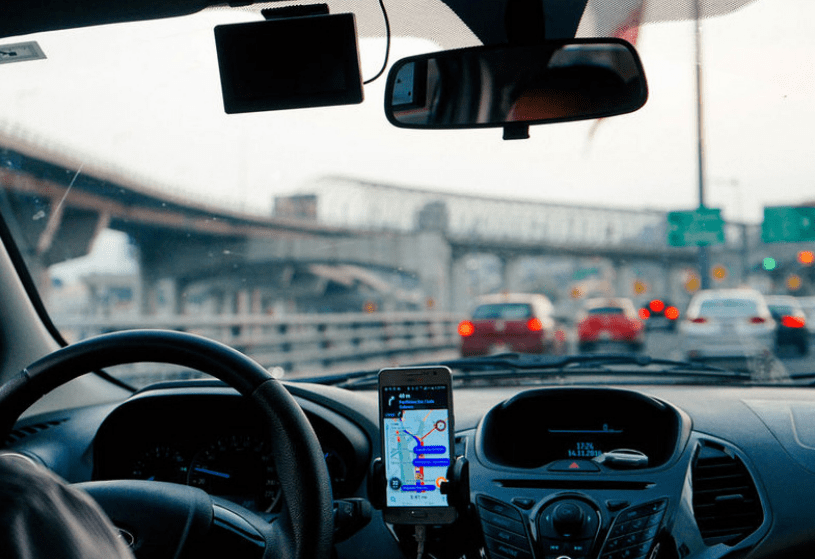App-based cab giants such as Uber and Lyft must use their high-tech savvy to cut back the amount of time their cars roam central Manhattan without any passengers in them — a new restriction announced Wednesday to reduce congestion in the traffic-plagued borough and increase speeds during the evening rush hour by up to 10 percent, city officials hope.
Uber, Lyft, Via, and Juno — which together had more than 86,000 vehicles on the road as of this March — must reduce the amount of time they cruise empty below 96th Street by 10 percent by next summer, from 41 percent of the time to 31 percent. If they violate the new restrictions, the city can impose harsh cash penalties or even yank their operating licenses from them, said Deputy Mayor for Operations Laura Anglin.
“They’re driving around, adding to congestion probably idling … maybe double parking,” Anglin told reporters during a rare, methodical and detail-filled City Hall briefing in advance of Mayor de Blasio's formal announcement hours later. "They want to keep ridership times very low and flood everywhere with cars, but a large portion of cars are empty.
"If they do not meet [the new restrictions]," Anglin continued, "there will be very severe penalties. And ultimately, if they are egregiously not meeting it, we can suspend license or actually revoke their license."

Last summer, when Mayor de Blasio announced a one-year limit on new app-based cab licenses, he also directed the Department of Transportation and the Taxi and Limousine Commission to study the effects of such high-volume for-hire vehicles on the road, including on congestion and street safety.
The study revealed what most people already knew just by sitting in a cab trying to get from one place to another — the app-based vehicles make up about 30 percent of traffic during peak periods in Manhattan below 60th Street. And a large chunk of that traffic stems from drivers waiting in Manhattan's central zone so that passengers get a cab mere minutes from clicking a button on their phones.
But the result is overwhelming gridlock, according to a table provided by the mayor's office:

Officials claim the new limitations will cut back on overall traffic within the central business district below 96th Street by about six to eight percent, allowing traffic speeds to jump by up to 10 percent, from seven miles-per-hour to 7.7 miles-per-hour.
The new cap should have very minimal effects on wait times for passengers.
“Wait times increase by less than one minutes, there's still plenty of cars to pick people up,” said Anglin.
Harsh fines will be the key to getting multi-billion-dollar companies to comply. If Uber, for example, continues an empty cruising rate of 42 percent, the city can slap the San Francisco-based company with a nearly $1 million fine each month. After that, if companies continue to violate the cap, the TLC can suspend a license for 30 days and then take it away entirely, said Anglin.
"We will be watching this very closely and making sure they stay within parameters,” she said. "We will revoke their license if they don't, I want to be clear about that."
The TLC will be able to monitor companies' cruising empty data through the same satellite mapping technology used today. The data are collected every two weeks. But it’s entirely up to the companies themselves to remodel how they do business in order to meet the threshold, said Anglin.
“It’s going to be ultimately their responsibility to ensure they’re staying within the cap," she said. "We on the back end will be taking data and making sure they are doing that every other week, if not we will levy fines." When asked by Streetsblog how the companies will do it, Anglin pointed out that Uber and Lyft are successful because of their technology.
"They know how to deploy vehicles," she said.
The new restrictions are a win for public transportation advocates fighting for better bus service, who say fewer for-hire vehicles clogging the road means more room for buses.
"Cutting the number of cars cruising Manhattan's gridlocked streets for fares will free up desperately needed room for stranded New York bus riders," said Riders Alliance Political Director Rebecca Bailin.
But not so fast, says transportation expert Charles Komanoff.
Komanoff estimates that the empty cruising reduction mandate from 41 percent to 31 percent will actually only increase speeds by a mere 2.5 percent. Given the current gridlock, that's still helpful, he added, but it's nowhere near the mayor's promised 10 percent.
The cruising empty cap was announced in conjunction with an indefinite extension on the limit on growth of licenses for companies like Uber and Lyft that Mayor de Blasio announced last summer.
But neither cap applies to yellow cabs, which the city says cruise empty roughly half the time they are on the road, and contribute to 24 percent of traffic in Manhattan below 60th Street. The difference, of course, is that yellow cabs can only accept street hails — and they now represent only a tiny portion of the cab market, city officials said.
A spokeswoman for Uber accused the de Blasio administration of unfairly targeting the high-volume, app-based vehicles and warned that the new restrictions will only lead to the same type of medallion crisis that wreaked havoc on the yellow cab industry, which the city is now trying solve.
“The mayor’s cap will create another medallion system — the same kind that bankrupted drivers and enriched lenders. Not only is the Mayor’s policy hurting app drivers by forcing them to pay exorbitant fees to rent a car, but he has proposed nothing to fix the current medallion system that only benefits lenders and taxi insiders,” said Alix Anfang in a statement.
Anglin said there would be no "new" medallion system because Uber and Lyft licenses are not transferable, but not everyone was convinced.
"The risk is that you create another medallion system on the for-hire side with all the unintended consequences that it had with the yellow cabs,” traffic expert Bruce Schaller told the Daily News. “I’ve been hearing that drivers are renting out their car for a second shift. Once you create an income flow for people who have a vehicle license, you’ve just created a new medallion system.”






